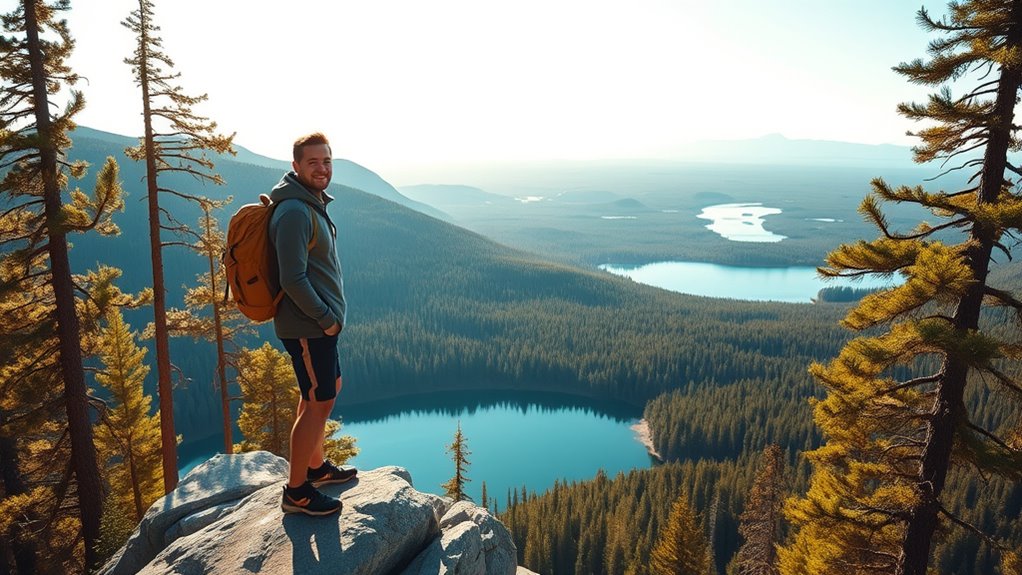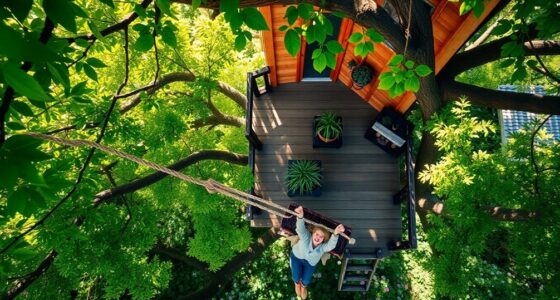Balancing adventure and mental health through nature involves setting realistic goals, listening to your body, and practicing mindfulness during outdoor activities. By taking regular rest, choosing environments that support your well-being, and building supportive communities, you can enhance your mental resilience while enjoying nature’s benefits. Incorporating self-care routines and fostering trust within groups helps prevent burnout and promotes emotional balance. Keep exploring to discover more ways to harmonize adventure with mental wellness.
Key Takeaways
- Incorporate outdoor mindfulness practices like sensory awareness and mindful breathing to deepen connection and reduce mental clutter.
- Set realistic goals aligned with your fitness and emotional capacity to prevent burnout and promote enjoyment.
- Prioritize rest and recovery days, listening to your body’s signals to maintain mental clarity and emotional balance.
- Engage in shared outdoor activities within a supportive community to foster connection, motivation, and mutual encouragement.
- Create safe, trusting environments that encourage honest communication and respect, enhancing emotional resilience amidst adventures.
Recognizing the Mental Health Benefits of Nature
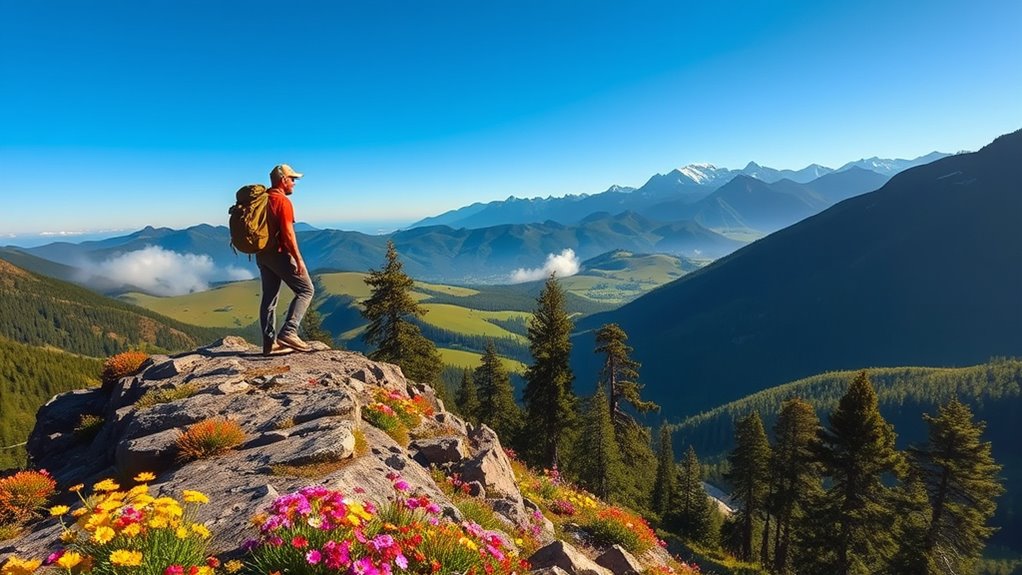
Spending time in nature has proven to boost mental well-being in numerous ways. Engaging in nature therapy allows you to disconnect from daily stressors and reconnect with your surroundings, fostering a sense of calm. Outdoor mindfulness encourages you to focus on the present moment, heightening awareness of sights, sounds, and sensations in your environment. These practices reduce anxiety and improve mood by activating your parasympathetic nervous system, which promotes relaxation. Recognizing the mental health benefits of nature helps you understand why spending time outdoors is essential for mental clarity and emotional resilience. Additionally, incorporating nature-based activities into your routine can further enhance these positive effects. Whether it’s a walk in the park or a hike through the woods, immersing yourself in nature offers valuable mental health support, making it a crucial part of a balanced life.
Setting Realistic Goals for Outdoor Activities
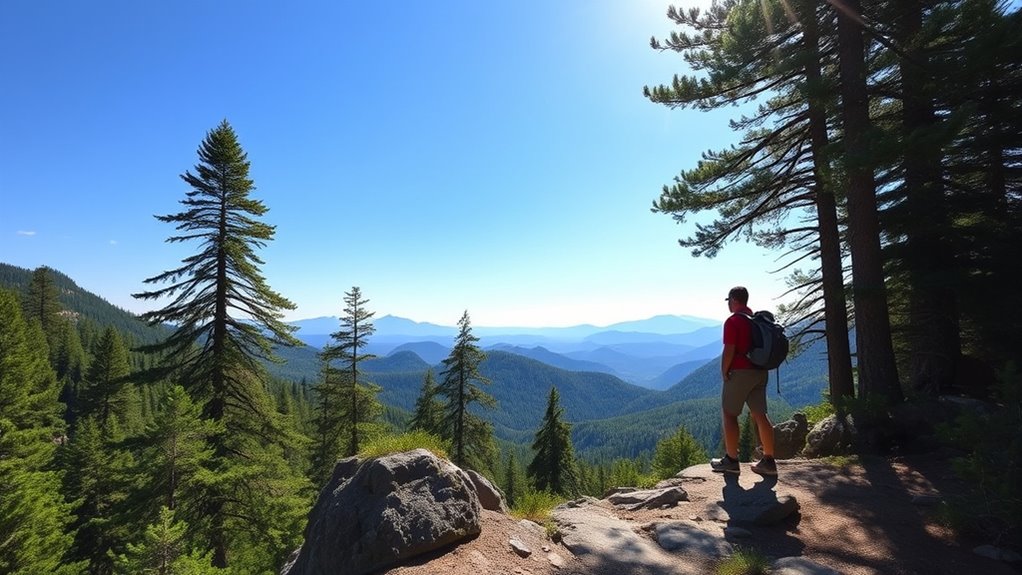
To enjoy outdoor activities without risking burnout or injury, it’s important to set realistic goals that match your current fitness level and schedule. Start by setting achievable targets that challenge you without overwhelming. Managing expectations is key—don’t aim for perfection or overly ambitious plans right away. Break larger goals into smaller, manageable steps to stay motivated and see progress. Be honest with yourself about your limits, and adjust your plans if needed. Remember, consistency matters more than intensity, so prioritize regular activity over pushing yourself too hard. Additionally, choosing appropriate exercise equipment and accessories can enhance safety and comfort during outdoor activities. By setting attainable goals, you’ll build confidence, enjoy your outdoor adventures more, and maintain a healthy balance that supports both your physical and mental well-being.
Listening to Your Body and Emotional Cues
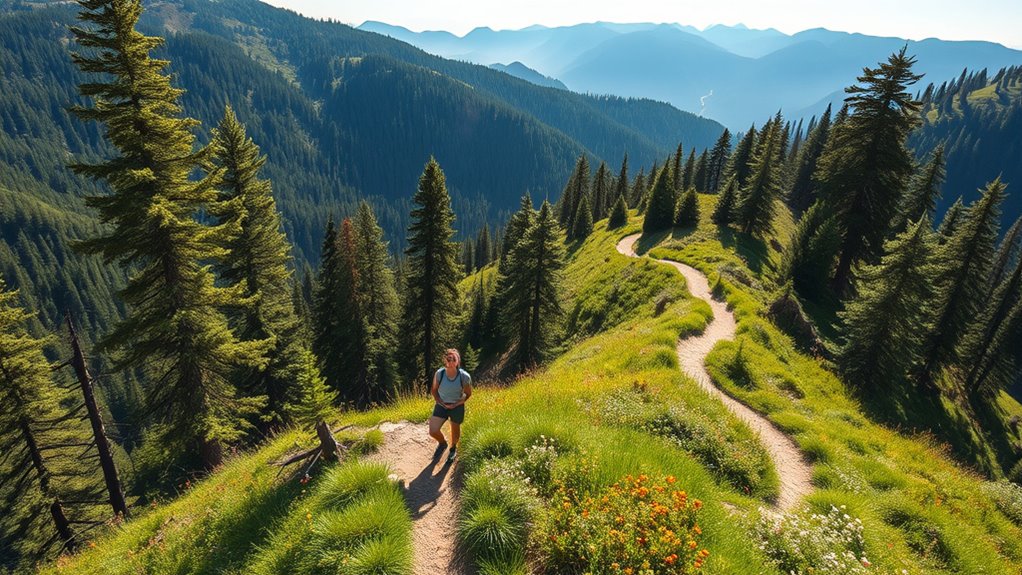
Listening to your body and emotional cues is essential for maintaining a healthy balance between adventure and well-being. Developing body awareness helps you recognize physical signs of fatigue, stress, or discomfort early, so you can adjust your activity accordingly. Emotional signals, like feelings of anxiety or excitement, offer insight into how your mind is responding to your environment. By paying attention to these cues, you prevent overexertion and avoid pushing yourself beyond your limits. This awareness allows you to stay attuned to what your body needs, whether it’s rest, hydration, or a mental break. Recognizing the importance of high refresh rates in your activities can also help you stay alert and responsive. Trusting these signals ensures you enjoy outdoor adventures while protecting your mental health, making your experiences both fulfilling and sustainable.
Incorporating Mindfulness Into Your Adventures
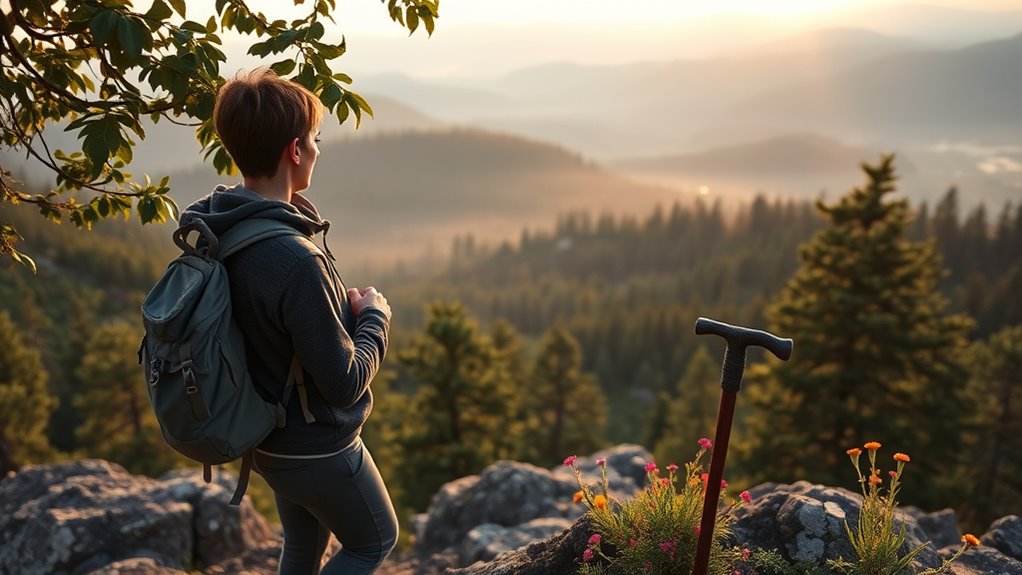
Incorporating mindfulness into your adventures allows you to fully engage with your surroundings and stay present in the moment. Start by practicing mindful breathing, paying close attention to each inhale and exhale. This simple act grounds you and calms your mind amid activity. As you move through nature, boost your sensory awareness by actively noticing sounds, textures, smells, and sights around you. Focus on what you’re experiencing without judgment, letting each sensation anchor you in the present. This mindful approach enhances your connection with nature and reduces mental clutter. Additionally, engaging in celebrity lifestyle insights can inspire you to incorporate enriching experiences into your own adventures. By intentionally incorporating these practices, you can deepen your appreciation of your environment while supporting your mental well-being during every adventure.
Ensuring Rest and Recovery in Your Routine

Ensuring adequate rest and recovery should be a vital part of your routine, especially after intense adventures or physical activity. Rest days give your body time to repair muscles, replenish energy, and prevent burnout. Incorporate self-care routines like gentle stretching, proper hydration, and quality sleep to support these recovery periods. Listen to your body’s signals—if you’re feeling fatigued or sore, prioritize rest over pushing through. Consistent rest not only boosts physical health but also helps maintain mental clarity and emotional balance. By scheduling regular rest days and practicing mindful self-care routines, you create a sustainable adventure lifestyle that nurtures both your body and mind. Remember, recovery is an essential component of staying energized and prepared for future adventures. Comfort solutions for sofa beds can also aid in creating a cozy environment that promotes relaxation during your downtime.
Selecting Suitable Environments for Personal Well-being
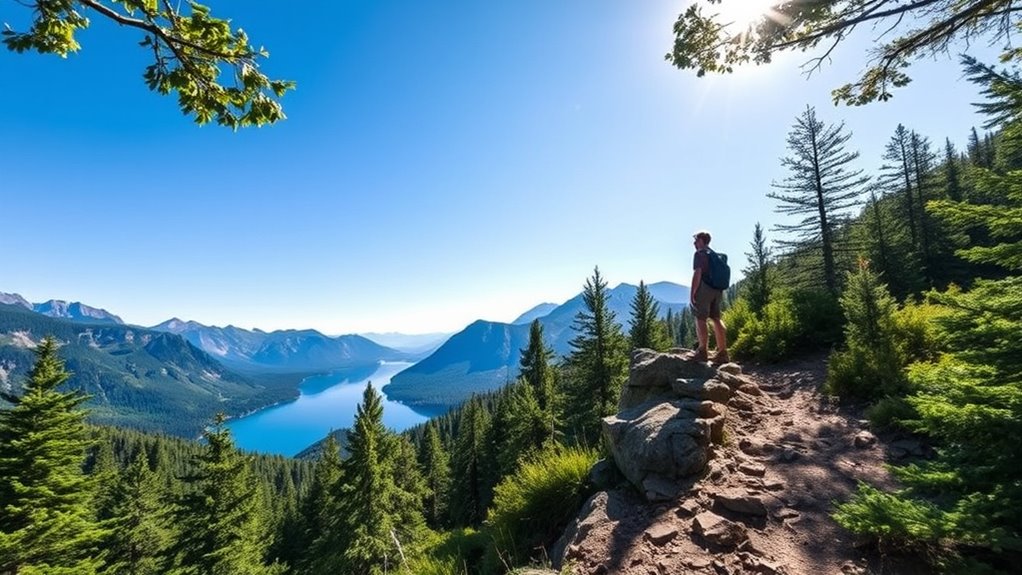
Choosing the right environment can considerably impact your mental well-being. Whether you find calm in a quiet forest, a lakeside retreat, or a cozy indoor space, selecting what feels most soothing is key. Consider your personal preferences to create a setting that nurtures your peace and balance. Additionally, understanding retail hours can help you plan visits to your favorite outdoor or indoor spaces without stress.
Nature Types for Calm
Finding the right natural environment can considerably boost your sense of calm and well-being. Forest therapy offers a peaceful setting where you can immerse yourself in nature’s tranquility, helping reduce stress and improve mood. Walking through lush trees, listening to rustling leaves, and breathing in fresh air calms your mind. Water-based activities, like gentle kayaking or shoreline strolls, also promote relaxation by connecting you with soothing sounds of water and gentle movement. These environments create a calming atmosphere that nurtures mental clarity and reduces anxiety. Choose settings where you feel comfortable and undisturbed, allowing you to fully engage with nature’s calming effects. Whether in a dense forest or beside a tranquil lake, these natural environments support your mental health through serenity and gentle connection. Creating Your Dream Backyard Greenhouse can also serve as a personal retreat for mental rejuvenation.
Personal Environment Preferences
Selecting environments that resonate with your personal preferences is essential for your well-being. If you find peace in lush greenery, garden retreats offer a tranquil escape where you can unwind and reconnect. On the other hand, urban parks provide a lively setting filled with activity, perfect if you thrive on social interactions and energetic pursuits. Consider what environment makes you feel most relaxed and rejuvenated—whether it’s the quiet of a secluded garden or the vibrancy of a busy park. Your personal preferences shape your mental health, so choose spaces that align with your needs. Regularly spending time in these environments helps you maintain balance, reduces stress, and boosts your overall mood. Tailoring your outdoor experiences to what suits you best enhances both adventure and mental well-being. Incorporating nature-based activities into your routine can further strengthen your connection with your chosen environment and support your mental health.
Building a Supportive Community for Shared Experiences
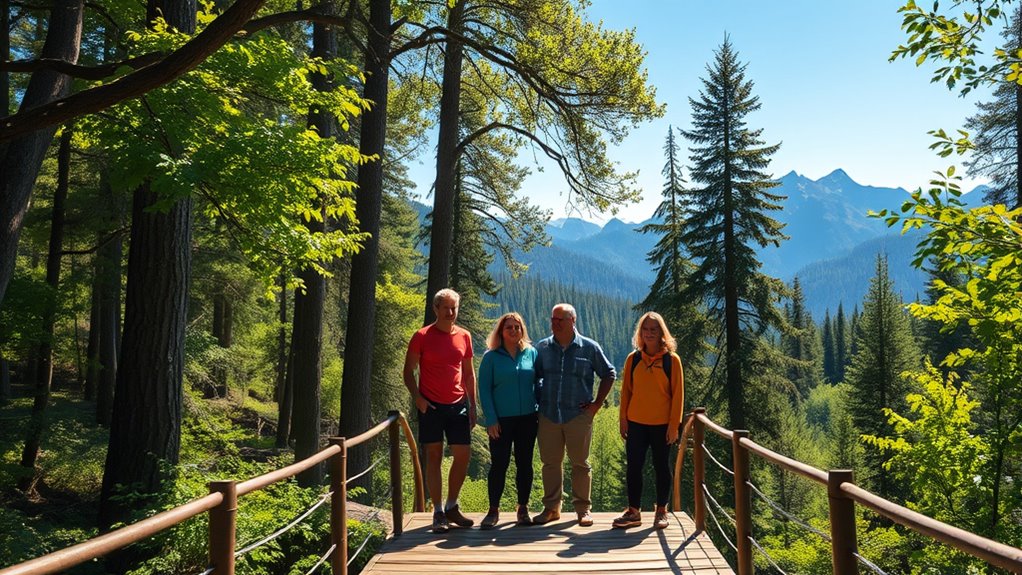
Building a supportive community starts with connecting through shared interests that inspire and motivate you. By creating safe spaces together, you foster trust and openness, making it easier to share your experiences. Encouraging mutual support helps everyone feel understood and resilient, strengthening your collective well-being. Incorporating beneficial ingredients like collagen and hyaluronic acid can enhance the overall experience and effectiveness of your shared self-care routines.
Connecting Through Shared Interests
Connecting through shared interests creates a powerful foundation for a supportive community, especially for those balancing adventure and mental health. When you bond over activities like nature photography, you share more than pictures—you share perspectives and experiences that deepen your connection. Outdoor cooking is another great way to bring people together, fostering teamwork and conversation around a campfire or picnic. These shared interests give you something tangible to connect on, reducing feelings of isolation. By participating in these activities, you build trust and encouragement with others who understand the importance of nature and adventure in maintaining mental well-being. Engaging in communal activities like pinball machines can also serve as a fun way to foster camaraderie and shared excitement. This sense of community not only enhances your outdoor experiences but also provides ongoing support when challenges arise.
Creating Safe Spaces Together
Creating safe spaces together is essential for fostering trust and openness within your community. When you establish an environment where everyone feels secure, sharing experiences becomes easier, strengthening bonds. To create trust, encourage honest conversations and active listening. Foster openness by respecting differing opinions and boundaries. Imagine a cozy campfire where everyone feels comfortable sharing stories, or a quiet trail where members listen without judgment. Consider setting ground rules that prioritize confidentiality and empathy. Visualize a circle of friends supporting each other’s journeys, with open hearts and minds. These elements help build a supportive community where shared adventures thrive, and mental health benefits deepen. By intentionally cultivating such spaces, you empower others to grow and connect authentically.
Encouraging Mutual Support
When you foster trust and openness in your community, encouraging mutual support naturally follows. Supportive communication helps members feel safe sharing their challenges and successes, strengthening bonds. By actively listening and offering genuine encouragement, you create an environment where everyone feels valued. Mutual encouragement becomes a daily practice, inspiring individuals to push their limits while respecting their boundaries. When people share their experiences honestly, it promotes empathy and understanding, making the community more resilient. As you emphasize collaboration over competition, members are more likely to support each other through setbacks and celebrate achievements together. Building this kind of supportive network not only enhances mental health but also enriches your collective adventure, creating a space where shared experiences foster growth and connection.
Frequently Asked Questions
How Can I Prevent Outdoor Activities From Becoming Stressful or Overwhelming?
To prevent outdoor activities from becoming stressful, focus on mindfulness techniques like deep breathing and staying present. Set clear boundaries for your activities, knowing your limits and avoiding overexertion. Take breaks when needed, and don’t hesitate to step back if you start feeling overwhelmed. By staying mindful and setting boundaries, you can enjoy outdoor adventures without stress, keeping your experience positive and fulfilling.
What Signs Indicate I Should Cut Back on Outdoor Adventures?
You might think you’re unstoppable, but signs of burnout and overexertion cues are telling you otherwise. If you notice persistent fatigue, irritability, or trouble sleeping after outdoor adventures, it’s time to cut back. When physical or emotional exhaustion takes over, your body’s warning signals are clear. Listening to these cues helps prevent burnout, ensuring you stay energized and safe while still enjoying nature’s benefits without risking overwhelm.
How Do I Balance Solitude and Socializing During Outdoor Activities?
To balance solitude and socializing during outdoor activities, pay attention to your needs. Engage in solo reflection when you crave quiet time, and join group activities when you want connection. Observe group dynamics to make sure you’re comfortable and not overwhelmed. Listen to your feelings, and switch between solitude and socializing as needed. This approach helps you enjoy nature’s benefits while maintaining mental balance and fulfilling your social needs.
What Safety Precautions Support Mental Health During Adventurous Outings?
Imagine the thrill of exploration, but don’t let safety slip away. You support your mental health by conducting thorough risk assessments before heading out, identifying potential hazards. Emergency preparedness is your safety net—carry a first aid kit, tell someone your plans, and know your routes. These precautions help you stay grounded, ensuring your adventure energizes rather than unsettles, letting you embrace nature’s beauty with confidence and peace of mind.
How Can I Adapt Outdoor Plans During Periods of Low Motivation or Mood?
When motivation dips or your mood drops, you can adapt outdoor plans by focusing on mental health strategies like setting small, achievable goals to boost motivation. Use motivation boosters such as listening to uplifting music or bringing a friend for support. Keep the activity simple and flexible, so you don’t feel overwhelmed. Remember, it’s okay to modify plans—your mental well-being matters most, and even small outdoor moments can lift your spirits.
Conclusion
By embracing nature with intention, you open a secret portal to your best self—more resilient, calmer, and happier than you ever imagined. When you balance adventure with self-care, you create a superpower that can conquer any storm life throws your way. So go ahead, plunge into the wild, but remember: your mental health is the treasure that makes every journey truly legendary. Treat it like the most precious gem in the universe.

